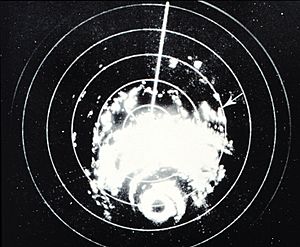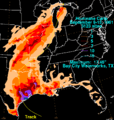Hurricane Carla facts for kids
| Category 5 major hurricane (SSHWS/NWS) | |

Satellite image of Hurricane Carla on September 10.
|
|
| Formed | September 3, 1961 |
|---|---|
| Dissipated | September 16, 1961 |
| Highest winds | 1-minute sustained: 175 mph (280 km/h) |
| Lowest pressure | 931 mbar (hPa); 27.49 inHg |
| Fatalities | 43 direct |
| Damage | $325 million (1961 USD) |
| Areas affected | Yucatán Peninsula, Texas, parts of the Central United States |
| Part of the 1961 Atlantic hurricane season | |
Hurricane Carla was a very powerful tropical cyclone that hit the Texas coast in 1961. It was one of the strongest storms to ever strike the United States. Carla was a Category 4 hurricane when it made landfall.
Even though it caused a lot of damage, over 500,000 people moved out of the storm's path. This huge evacuation helped keep the number of deaths low, with only 43 people killed.
Contents
How Hurricane Carla Formed and Grew
Hurricane Carla started as a tropical depression on September 3, 1961. It formed in the western Caribbean Sea. A tropical depression is like a baby hurricane, a swirling area of low pressure.
It slowly moved northwest. On September 5, it became Tropical Storm Carla. The next day, September 6, it grew into a full hurricane.
Carla first touched the Yucatán Peninsula as a weaker hurricane. Then, it moved into the Gulf of Mexico. It headed straight for the U.S. Gulf Coast.
Carla Becomes Super Strong
As Carla moved across the Gulf of Mexico, it got much stronger. On September 11, its winds reached 175 miles per hour (280 km/h). This made it a Category 5 hurricane, the highest category!
Just before hitting land, Carla weakened a little. But it was still a very strong and huge Category 4 hurricane. It hit the coast between Port O'Connor and Port Lavaca, Texas on September 11.
At that time, Carla was the largest hurricane ever recorded in the Atlantic Ocean. People living along the entire Texas coast were warned. Many were told to leave their homes in low-lying areas.
What Happened When Carla Hit
When Hurricane Carla hit, it caused a lot of damage. The storm surge, which is a rise in sea level caused by the storm, was very high. It reached 22 feet (6.6 meters) in some places. This huge wall of water pushed inland for up to 10 miles.
Because Carla was so big, the entire Texas coast felt its power. Damage was even seen as far away as Dallas. Winds were reported at 115 mph in Matagorda and 110 mph in Victoria. Wind gusts reached an amazing 170 mph in Port Lavaca.
The pressure at the center of the storm was very low, 931 mb. This made Carla the eighth most intense hurricane to hit the United States in the 20th century.
First Live TV Broadcast
A news reporter named Dan Rather reported live from the Galveston Seawall during the storm. This was a big deal because it was the first time a hurricane was shown live on television. Other reporters later copied this brave act.
Tornadoes and Flooding
Carla also caused one of the biggest outbreaks of tornadoes ever seen from a hurricane. A total of 26 tornadoes touched down. One very strong tornado, an F4, tore through downtown Galveston. It sadly killed several people.
Outside the protection of the Galveston Seawall, many buildings on the island were badly damaged by the storm surge. Damage was even reported far away, near the Mississippi River delta.
As Carla moved inland and got weaker, it dropped heavy rain. This caused some flooding in the Midwest.
Damage and Evacuation
Carla killed 43 people, with 31 of those deaths happening in Texas. This number was very low because of a massive evacuation. About half a million people moved away from the coast to safer areas. This was the largest movement of people in U.S. history outside of wartime.
The hurricane caused about $325 million in damage in 1961. This amount would be about $2.36 billion today. Considering how strong Carla was, the damage wasn't as high as it could have been, thanks to the evacuations.
Why Hurricane Carla's Name Was Retired
Because Hurricane Carla was so strong and caused so much destruction, its name was "retired." This means the name Carla will never be used again for an Atlantic hurricane. This is done to honor the victims and prevent confusion with future storms. The name Carol was used instead in the 1965 season.
Related pages
Images for kids
-
A house destroyed by Hurricane Carla in Port O'Connor, Texas
-
Sign showing the highest water level of Hurricane Carla in Galveston
See also
 In Spanish: Huracán Carla para niños
In Spanish: Huracán Carla para niños







